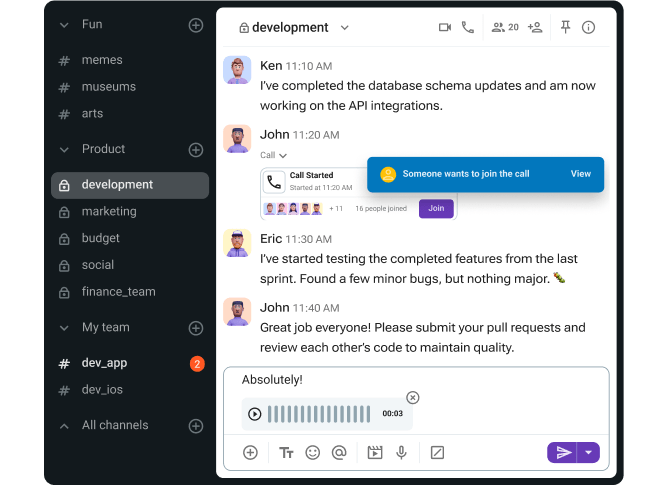La colaboración es un proceso delicado y sensible cuyos resultados están determinados por un número indefinido de factores.
No solo necesita estar bien organizada, sino también cuidadosamente seleccionada, modificada y mantenida a lo largo de las distintas etapas y aspectos de su curso.
Si dedicas suficiente tiempo al trabajo colaborativo, seguramente se revelarán sus numerosos beneficios. Sin embargo, es casi seguro que también experimentarás el estrés, la frustración y la ineficiencia que inevitablemente surgen de vez en cuando cuando se trabaja con otros.
La colaboración en sí no elimina inherentemente ninguno de estos inconvenientes. En cambio, depende de los equipos y las organizaciones crear un entorno que facilite su eliminación, minimización y/o gestión.
En este artículo, nos centramos en las aplicaciones prácticas del trabajo colaborativo y las prácticas y principios clave que pueden ayudar a elevarlo a un nivel superior.

¿Por qué la colaboración productiva en equipo es crucial para todas las empresas?
Hace mucho tiempo, Hellen Keller dijo: “Solos podemos hacer muy poco; juntos podemos hacer mucho.“
Steve Jobs implementó esta noción en un entorno empresarial y dijo: “Las grandes cosas en los negocios nunca las hace una sola persona; las hace un equipo de personas.”
La importancia de la colaboración en equipo ha sido reconocida sin lugar a dudas desde entonces, especialmente en el mundo agitado de hoy, donde las empresas enfrentan problemas reales en términos de mejorar la colaboración y la productividad en equipo.
La epidemia de burnout, los desafíos de los modelos de trabajo remoto e híbrido, y la lucha por establecer límites entre el trabajo y la vida personal han llevado a la creciente importancia de la colaboración eficaz en equipo. Pero, lograr una buena colaboración en equipo es ciertamente más fácil de decir que de hacer.
Por otro lado, la sobrecarga colaborativa no es un mito.
Según un artículo de Harvard Business Review, la sobrecarga colaborativa se define como la influencia negativa de demasiado trabajo en equipo, que conduce a una menor productividad y a que los empleados se sientan agotados.
Los datos han demostrado que en muchas empresas más del 80% del tiempo de trabajo se dedica a actividades colaborativas como:
- Responder correos electrónicos,
- Hacer llamadas de voz,
- Attending meetings, etc.
Esta cifra aumentó progresivamente durante la pandemia ― como mencionamos, los modelos de trabajo remoto e híbrido han planteado nuevos desafíos en términos de colaboración, ya que las reuniones virtuales se han convertido en la nueva normalidad diariamente.
Sin embargo, las encuestas muestran que el 39% de los empleados cree que las personas de su organización no colaboran lo suficiente.
Considerando todo, podemos concluir que la colaboración productiva en equipo requiere mantener un buen equilibrio. Si bien debe priorizarse la colaboración en equipo, es necesario evitar la sobrecarga colaborativa encontrando un equilibrio con las actividades colaborativas.
¿Cuáles son los principales beneficios de un equipo colaborativo?
Antes de profundizar en las mejores prácticas para una colaboración productiva en equipo, echemos un vistazo a los mayores beneficios de un equipo colaborativo.
Beneficio 1: Un equipo colaborativo contribuye a la resolución de problemas
“Dos cabezas piensan mejor que una.”
― John Heywood
La sinergia del equipo potencia la colaboración en equipo con diferentes perspectivas que pueden aportar nuevos valores. Esto ayuda a los miembros del equipo a hacer su mejor trabajo.
En otras palabras, dos o más personas tienen más probabilidades de encontrar soluciones relevantes y tomar mejores decisiones que una sola persona.
Combinar el conocimiento de los miembros del equipo y compartir ideas y pensamientos es uno de los mayores poderes de la colaboración en equipo.
Resuleve problemas y organiza una lluvia de ideas en Pumble
Beneficio 2: Un equipo colaborativo fomenta el intercambio de habilidades y conocimientos entre los miembros del equipo
Además de contribuir a la resolución de problemas, una cultura colaborativa sólida permite que los miembros del equipo aprendan unos de otros.
El intercambio de habilidades y conocimientos entre miembros del equipo con diferentes antecedentes, niveles de experiencia y puntos de vista conduce a una mayor productividad.
Beneficio 3: Un equipo colaborativo aumenta la productividad y el compromiso
Según un artículo de Forbes sobre la influencia de la colaboración en la productividad de los empleados, un entorno colaborativo “crea una fuerza laboral comprometida en la que cada persona se siente como un miembro contribuyente de un equipo unificado”.
Además, los estudios muestran que esta experiencia les otorga una mayor motivación intrínseca, lo que conduce a un mayor compromiso y un 50% más de efectividad a la hora de completar las tareas.
Por lo tanto, la dinámica de la colaboración efectiva no solo contribuye a la resolución de problemas y al intercambio de conocimientos, sino que también mejora la salud mental de las personas involucradas.
Los 5 principios de una buena colaboración
En su influyente obra How to Make Collaboration Work, el autor David Straus se propuso ofrecer consejos para la creación de un entorno colaborativo productivo que evite los efectos secundarios negativos del proceso y enfatice los valores de la colaboración y los aspectos agradables de trabajar juntos.
Explorador y practicante de toda la vida de la “resolución colaborativa de problemas”, Straus se ha basado en décadas de su experiencia como líder, consultor y formador para condensar los 5 principios clave de una colaboración eficaz.
Los 5 principios de Straus son:
- Involucrar a las partes interesadas relevantes.
- Conseguir consenso fase por fase.
- Diseñar un mapa de procesos.
- Designar un facilitador del proceso.
- Aprovechar el poder de la memoria grupal.
En las siguientes líneas, los analizaremos todos en profundidad.
Principio 1: Involucrar a las partes interesadas relevantes
“El poder de la colaboración proviene de la inclusión, no de la exclusión.”
– David Straus
En principio, puede parecer obvio que la colaboración debería incluir a todos aquellos que tengan un interés activo en su resultado y/o la experiencia relevante.
Sin embargo, en la práctica, esto no suele ser así. A menudo se excluye del proceso a individuos y grupos que pueden tener un impacto significativo en el curso de la colaboración.
Esto puede ocurrir de manera involuntaria, cuando una organización no identifica adecuadamente a los participantes relevantes, o de manera intencional, si se considera que una persona o un grupo en cuestión es conflictivo u opuesto a la colaboración o las actividades planificadas, a pesar de poseer la experiencia relevante o influencia en el proceso de toma de decisiones.
Para identificar adecuadamente a todas las partes relevantes, Straus ha creado cuatro categorías de partes interesadas relevantes:
- Aquellos con el poder formal para tomar una decisión,
- Aquellos con el poder de bloquear una decisión,
- Aquellos afectados por una decisión, y
- Aquellos con información o experiencia relevante.
Mantén a todas informados con Pumble
Categoría 1: Aquellos con el poder formal para tomar una decisión
La participación de los tomadores de decisiones formales otorga peso y relevancia al proceso de colaboración. Cuanto más involucrados estén, la colaboración será más sólida y tendrá mayor impacto.
Por otra parte, la falta de participación de los tomadores de decisiones devalúa la colaboración, ya que cualquier decisión tomada conjuntamente por el grupo colaborativo puede ser descartada en un nivel superior.
Categoría 2: Aquellos con el poder de bloquear una decisión
A diferencia del primer tipo de parte interesada, este tipo no tiene poder formal para tomar decisiones, pero aun así tiene el poder de obstaculizar significativamente la implementación de cualquier decisión o bloquearla por completo al:
- No actuar,
- Retener información,
- Hacer llamadas telefónicas para informar,
- Oponerse a través de canales formales, etc.
Obtener el apoyo de tales individuos o grupos puede ser crucial para el éxito de una colaboración.
Involucrar a los potenciales bloqueadores de decisiones en la colaboración fortalece el proceso, mientras que su exclusión conducirá inevitablemente a resistencia y amenazará la implementación del esfuerzo conjunto.
Si bien la idea de excluir a los colaboradores potencialmente problemáticos puede sonar tentadora, solo les daría a los bloqueadores más poder, ya que podrían afirmar con razón que el proceso no fue justo e inclusivo. Por el contrario, su participación puede llevar a su plena adopción del proceso, si el resto del equipo escucha de verdad y tiene en cuenta sus aportaciones.
Categoría 3: Aquellos afectados por una decisión
El grupo más amplio de partes interesadas por defecto, aquellos que se ven afectados por los resultados del proceso colaborativo, puede incluir a toda una organización o una comunidad.
Sin embargo, en la mayoría de los casos, incluye un subconjunto más reducido de personas directamente afectadas por los resultados o preocupadas por ellos.
La participación de este grupo es esencial por varias razones:
1. Si se tienen en cuenta sus aportaciones en el proceso de toma de decisiones, es más probable que apoyen las decisiones, mientras que la exclusión de sus puntos de vista puede convertirlos fácilmente en bloqueadores de decisiones.
2. Como serán los más afectados por las decisiones, no solo es respetuoso sino también muy práctico tener en cuenta sus aportaciones.
Si el grupo afectado es demasiado grande para cuestiones prácticas (reuniones, consultas, etc.), sus voces pueden escucharse a través de un representante elegido que aportará la perspectiva del grupo.
Categoría 4: Aquellos con información o experiencia relevante
En la mayoría de los casos, la inclusión de los primeros tres grupos proporcionará al equipo colaborativo la experiencia suficiente.
Sin embargo, esto no siempre sucede. Es importante evaluar adecuadamente los recursos disponibles y determinar si se requiere experiencia adicional.
Si la experiencia requerida no se puede encontrar dentro de la organización, se debe considerar la posibilidad de contratar expertos externos.
Principio 2: Conseguir consenso fase por fase
Las decisiones alcanzadas por consenso tienen una gran importancia para el proceso colaborativo.
Si las decisiones se toman colectivamente, todos los participantes tendrán un mayor grado de compromiso con su implementación.
Además, las decisiones por consenso tienden a ser mejores que las decisiones alcanzadas por votación mayoritaria o por toma de decisiones jerárquica.
Alcanzar un consenso no siempre es un proceso sencillo y directo. Straus sugiere que eso sucede porque a menudo se le presenta al equipo colaborativo una solución propuesta sin ninguna participación previa en las etapas anteriores de su formulación.
En cambio, propone el involucramiento de todos los participantes en todo el proceso de definición de un problema y formulación de soluciones potenciales.
Las 6 etapas de la construcción de consenso
Straus identifica 6 etapas distintas para alcanzar el consenso:
- Percepción ― ¿Existe un problema y se debe abordar?
- Definición ― ¿Cuál es el problema?
- Análisis ― ¿Cuál es la causa del problema?
- Generación de alternativas ― ¿Cuáles son las posibles soluciones?
- Evaluación ― ¿Cómo se comparan las soluciones propuestas entre sí?
- Toma de decisiones ― ¿Cuál es la solución con la que estamos de acuerdo?
Se alcanzará un consenso sobre el curso de acción final más fácilmente si un equipo toma continuamente decisiones de consenso “más pequeñas” a lo largo de las primeras etapas del proceso.
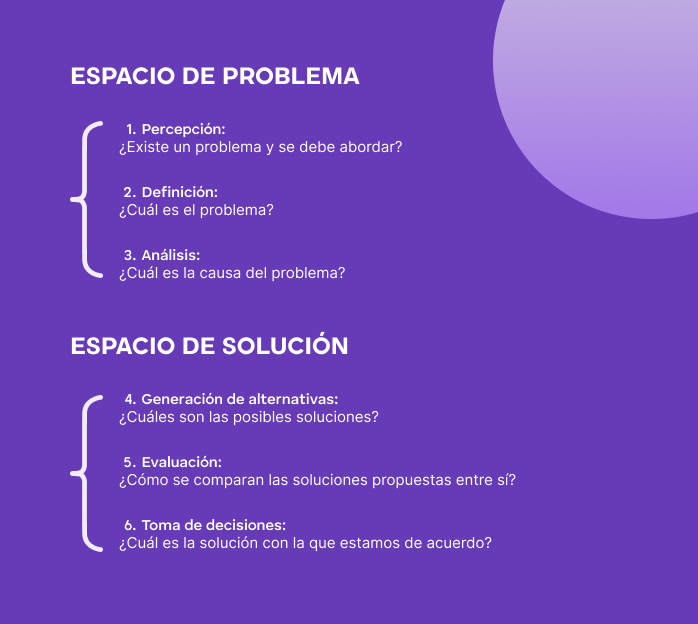
Los mecanismos del plan B
No siempre es posible alcanzar un consenso.
En ocasiones, los puntos de vista alternativos están demasiado alejados como para encontrar un punto medio. En tales situaciones, insistir en el consenso puede llevar mucho tiempo y ser ineficaz.
Los equipos colaborativos deben idear un mecanismo de respaldo para la toma de decisiones en situaciones en las que el consenso es imposible. Estos mecanismos pueden ser una decisión jerárquica o una votación por mayoría, un juego de piedra, papel o tijera o cualquier otro modelo acordado previamente.
Tener un mecanismo del plan B no solo mantiene el proceso de toma de decisiones en marcha, sino que también puede motivar a los participantes a trabajar para lograr el consenso, ya que el consenso siempre se percibirá como preferible a la alternativa.
Es importante que el mecanismo de respaldo se comunique por completo y que los participantes sean conscientes de las consecuencias de no alcanzar un consenso.
Principio 3: Diseñar un mapa de procesos
La colaboración no se produce de manera espontánea. Debe ser:
- Planificada,
- Estructurada, y
- Facilitada.
Antes de que la colaboración pueda siquiera comenzar, hay una gran cantidad de información que ya debe estar en su lugar.
Para comprometerse plenamente, los participantes deben tener una comprensión completa de cómo se llevará a cabo la colaboración:
- ¿Cómo funcionará el proceso?
- ¿Quién participará y en qué capacidad?
- ¿Cuáles son las responsabilidades específicas, los plazos, los recursos?, etc.
Si bien es imposible prever completamente el curso y los resultados de la colaboración, podemos definir el marco de procedimientos y planificar los procesos para alcanzar un consenso e implementar las soluciones acordadas. Definimos el camino hacia la acción sin saber cuál será la acción.
Straus define este marco de procedimientos como un "mapa de procesos". Es un conjunto de roles y procesos definidos y acordados colectivamente que predice los pasos en el proceso de colaboración. Piénsalo como una agenda de reunión bien estructurada, solo en un nivel superior.
El mapa de procesos debe ser lo suficientemente detallado en términos de los mecanismos de colaboración, pero lo suficientemente flexible para facilitar la naturaleza impredecible de prueba y error de la resolución colaborativa de problemas.
Si tomamos la agenda de la reunión como un microejemplo de un mapa de procesos, no predice el curso de la discusión ni las conclusiones, pero puede definir:
- Puntos de discusión,
- Roles específicos,
- Líneas temporales, y
- Otros detalles que aseguren que la reunión se lleve a cabo de manera eficiente.
Puede ser un documento o un diagrama muy detallado, una combinación de ambos, o incluso un acuerdo verbal no escrito entre todos los participantes. Lo importante es definir colectivamente y comunicar claramente los procesos y los mecanismos de colaboración.
Además de tener un proceso estructurado, también permite a los participantes comprometerse plenamente con el trabajo compartido con la seguridad de que se llevará a cabo de manera organizada.
Principio 4: Designar un facilitador del proceso
En la mayoría de las colaboraciones, la resolución de problemas y la toma de decisiones compartida se realizan en reuniones. Por lo tanto, las reuniones son una parte fundamental del proceso colaborativo y su eficacia es esencial para el éxito del esfuerzo conjunto.
Llevar a cabo una reunión eficaz incluye múltiples responsabilidades:
- Definir una agenda de la reunión,
- Asegurarse de que todos tengan la oportunidad de decir lo que piensan,
- Mantener registros, y
- Tomar decisiones.
Es mucho pedir que alguien asuma todas estas responsabilidades Y participe activamente en la discusión.
Para aliviar a una persona de una carga tan pesada de responsabilidades, Straus propone la idea de la responsabilidad compartida por el éxito de la reunión entre todos los participantes. Esto implica diferenciar roles y que diferentes personas atiendan diferentes aspectos de la reunión.
Straus define 4 roles distintos en una reunión:
- Facilitador: un participante neutral e imparcial centrado en el proceso
- Registrador: una persona responsable de mantener registros de la reunión
- Líder: gerente sénior, responsable de asegurarse de que el equipo se mantenga concentrado en la tarea en cuestión y, más comúnmente, de tomar una decisión si no se puede llegar a un consenso
- Miembro del grupo: participante activo centrado en la resolución de problemas
Todos los participantes son responsables de asegurarse de que los demás no se salgan de sus roles. Es decir, el facilitador evita que el líder domine la reunión, y el líder y los miembros del grupo se aseguran de que el facilitador y el registrador permanezcan neutrales.
Si bien prestaremos más atención al papel del registrador en la siguiente sección de este artículo, ahora nos centraremos en el facilitador.
Idealmente, un facilitador es alguien fuera del grupo colaborativo que no se ve afectado inmediatamente por los resultados de la colaboración, por ejemplo, un miembro del personal de RR.HH. Esto es importante para garantizar la neutralidad y su enfoque en el proceso, y no en el contenido de la reunión.
Organiza reuniones de equipo en Pumble
Funciones del facilitador
El facilitador tiene 4 funciones principales:
- Guía del proceso: responsable del proceso de colaboración sin evaluar ni aportar aportes personales a la discusión, así como desarrollar una agenda de la reunión y manejar la logística de la misma.
- Proveedor de herramientas: responsable de ofrecer sugerencias de proceso (diferentes métodos de resolución de problemas y toma de decisiones) y asegurarse de que todos tengan claro el método elegido.
- Tercero neutral: responsable de eliminar cualquier conflicto de intereses y el ejercicio excesivo de influencia respetando el proceso y asegurando que se escuchen y comprendan los aportes de todos.
- Educador del proceso: responsable de educar a los participantes sobre el proceso mientras lo facilitan, demostrando técnicas (planificación del proceso, aclaración de roles, herramientas básicas de resolución de problemas) que conduzcan al consenso y a una colaboración productiva.
Principio 5: Aprovechar el poder de la memoria grupal
Las reuniones grabadas desempeñan un papel importante en el proceso colaborativo. No solo sirven como registro de los puntos clave de discusión para su posterior consideración, sino que también pueden desempeñar un papel en la moderación de la reunión en tiempo real.
Straus propone un rol neutral para el registrador, cuya única responsabilidad es capturar las ideas y conclusiones clave presentadas en una reunión.
Además, todos los participantes son responsables del contenido del registro, ya que el registrador captura los puntos clave de la discusión de una manera transparente y visible para todos (es decir, en un bloc de notas, una pizarra o un documento interactivo).
El registrador no debe parafrasear lo que se ha dicho, y los participantes deben corregir al registrador si no están de acuerdo con los registros. Straus llama a este enfoque colaborativo para el registro de reuniones "memoria grupal".
Mantener registros transparentes de reuniones en tiempo real ayuda a mantener una discusión eficaz y a cumplir los objetivos de la reunión al brindar claridad y evitar la repetición, la confusión y la ambigüedad.
En términos prácticos, Straus propone que los asientos de la sala de reuniones se coloquen en forma de U frente a un bloc de notas, de modo que todos puedan seguir la creación de registros y hacer las correcciones necesarias.
Por supuesto, los equipos colaborativos son libres de explorar y diseñar sus propios métodos específicos para mantener registros de reuniones, siempre que aseguren la transparencia y la participación de todos los involucrados.
Los 9 consejos para crear un equipo positivo y productivo
Jon Gordon, el autor de otro influyente libro sobre trabajo en equipo The power of a positive team, destaca la importancia de la energía positiva en un equipo, que ayuda a los miembros del equipo a comprometerse y generar un mayor impacto.
Según su creencia, los miembros de los equipos positivos tienen varias tendencias cruciales en común:
- Invierten su tiempo y energía para crear un ambiente de trabajo positivo,
- Trabajan juntos hacia una visión, que refleja un propósito mayor, y
- Trabajan con optimismo.
Así que, profundicemos en cada uno de estos comportamientos y analicemos cómo generan un impacto positivo.
Consejo 1: Invierte tu tiempo y energía en crear una cultura de equipo positiva
La cultura de equipo define las creencias y expectativas del equipo, que influyen en las conductas de los miembros del equipo y en el futuro del equipo. Como dice Gordon, la cultura de equipo positiva es beneficiosa para sus miembros de muchas maneras:
- Mejora la conexión entre los miembros del equipo,
- Da energía y anima a los miembros del equipo, y
- Los ayuda a aprender y crecer.
Aunque los líderes tienen un gran impacto en la dinámica del equipo, esta es creada por todas las partes involucradas: un equipo es dinámico, por lo que cada miembro del equipo tiene un impacto con sus palabras, comportamientos e interacciones con los demás.
Gordon cree que el error más común que cometen los equipos es centrarse en el resultado o el "fruto" en lugar de la "raíz": el proceso, las relaciones entre los miembros del equipo y su cultura.
Además, los estudios del Heart Math Institute indican que todos transmitimos a los miembros de nuestro equipo cómo nos sentimos. La actitud y la energía de cada miembro del equipo son contagiosas: afectan a las personas que nos rodean.
Consejo 2: Trabaja hacia una "visión compartida" con un propósito mayor en mente
Según Gordon, los factores clave de cada colaboración productiva en equipo son:
- Una "visión compartida" que inspira a los miembros del equipo de manera individual y colectiva, y
- Un propósito mayor de por qué están comprometidos con esa visión.
A diferencia de los objetivos numéricos, los objetivos impulsados por un propósito empoderan a los miembros del equipo con mayor compromiso y energía. Por lo tanto, siempre intenta identificar el propósito del esfuerzo de tu equipo, en lugar de centrarse únicamente en el número que quieres alcanzar.
Lo más importante es mantener viva la visión y el propósito. Gordon descubrió que la mayoría de los equipos dejan que su visión y propósito se desvanezcan. Debido a este problema, es imprescindible hablar de estos conceptos de manera regular.
“Es muy importante que cada miembro del equipo identifique y comparta lo que significan para él la visión y la misión y cómo puede contribuir a ellas.”
Consejo 3: Ve los desafíos como nuevas oportunidades
Todos los equipos tienen altibajos: los fracasos son inevitables y naturales. Pero, cuando un equipo se enfrenta a desafíos, sus participantes deben verlo como una oportunidad para aprender y crecer.
En lugar de sentirse frustrados por un obstáculo, las personas deben tratar de comprender cómo superarlo y qué deben aprender de él para el futuro.
Consejo 4: Implementa la “regla de no quejarse”
Aunque quejarse es parte de la naturaleza humana, caer en ese hábito mental negativo es perjudicial para mantener relaciones interpersonales saludables, así como para alcanzar metas personales.
La gente suele quejarse para comunicar su insatisfacción y sentirse comprendida.
Sin embargo, si las quejas no van seguidas de soluciones, son inútiles y tóxicas. Es decir, una investigación ha demostrado que los pensamientos negativos tienen un mayor impacto en nuestro cerebro que los pensamientos positivos.
Por lo tanto, los equipos positivos implementan la “regla de no quejarse”: no te quejes a menos que tengas una solución. Con esta regla, los equipos pueden eliminar con éxito la toxicidad y empoderar a los miembros del equipo para que piensen y se comporten de manera constructiva al centrarse en las soluciones.
🎓 Consejo Pro de Pumble
La mayoría de las personas se han encontrado en una situación en la que se les pidió que asumieran responsabilidades adicionales. En lugar de quejarse, aprende a establecer límites de manera profesional. Consulta la publicación de nuestro blog:
Comunica tus necesidades a través de Pumble
Consejo 5: Discrepa, pero de manera positiva
Aunque algunas personas tienden a evitar los desacuerdos para mantener la armonía y la positividad en el lugar de trabajo, los desacuerdos constructivos y respetuosos son una parte saludable de la colaboración en equipo.
Gordon enfatiza la necesidad de que haya conflictos en el equipo. Si nunca ocurren, significa que nadie está haciendo preguntas difíciles ni discutiendo cuestiones importantes.
La ausencia de conflictos indica que nadie cuestiona las opiniones de los demás miembros del equipo ni critica a los demás para mejorar.
Por lo tanto, los desacuerdos pueden contribuir a la formación de equipos saludables y productivos al brindar mejores soluciones y oportunidades de crecimiento.
Consejo 6: Prioriza la comunicación
Gordon dice: “La comunicación es a menudo lo último que quieres hacer, pero es lo más importante que debes hacer.”
La comunicación en equipo es esencial para generar confianza y compromiso. Para construir un equipo fuerte, los miembros del equipo necesitan una comunicación fuerte, lo que implica habilidades para:
- Hablar de manera efectiva,
- Escuchar atentamente,
- Recibir feedback, y
- Usar información procesada para tomar decisiones que sean en el mejor interés del equipo.
Según el modelo 3C de equipos multifuncionales, el trabajo en equipo de alto rendimiento consta de tres elementos que representan actividades relacionadas:
- Comunicación,
- Colaboración, y
- Coordinación, lo que implica visibilidad del progreso y las direcciones de cada equipo.
Por lo tanto, estos elementos son actividades centrales de cada equipo multifuncional, así como de un equipo funcional.
🎓 Consejo Pro de Pumble
Hablando de habilidades de comunicación en equipo, es muy importante ser un oyente activo. Para mejorar tus habilidades de escucha activa, asegúrate de consultar nuestro artículo:
Una excelente manera de fortalecer la conexión y la colaboración en equipo es tener conversaciones individuales.
Cuando se trata de la comunicación entre un líder de equipo y un miembro del equipo las reuniones individuales son una forma especialmente eficaz de mantener a los miembros del equipo comprometidos y motivados.
Consejo 7: Tómate tiempo para la comunicación uno a uno
Más importante aún, esta es una forma valiosa de superar los desafíos y encontrar obstáculos relacionados con la colaboración en equipo.
Las reuniones individuales frecuentes y breves son uno de los métodos de colaboración más eficaces que ayudan a los miembros del equipo a mantenerse en el buen camino y encontrar su propósito superior.
Organiza reuniones individuales en Pumble
Consejo 8: Comunícate de manera eficaz con una aplicación de colaboración en equipo
Hablando de las prácticas de comunicación más eficaces, saber qué método de comunicación utilizar es tan importante como la forma en que nos comunicamos con nuestros compañeros de trabajo.
Por lo tanto, elegir la herramienta de comunicación adecuada que satisfaga las necesidades del equipo es una prioridad y la única forma de garantizar una comunicación eficaz en equipo.
Pumble es un software de colaboración en equipo que ayuda a los equipos remotos a difuminar la línea entre la comunicación real y virtual y a colaborar de manera fácil y eficaz. Con Pumble, puedes:
- Trabajar con tu equipo en canales y mensajes directos,
- Compartir archivos,
- Hacer llamadas de voz y vídeo, y más.
Una de las mejores características de Pumble es un historial de chat gratuito, por lo que los usuarios pueden ver el historial de mensajes completo de todas las conversaciones desde el principio de forma gratuita.
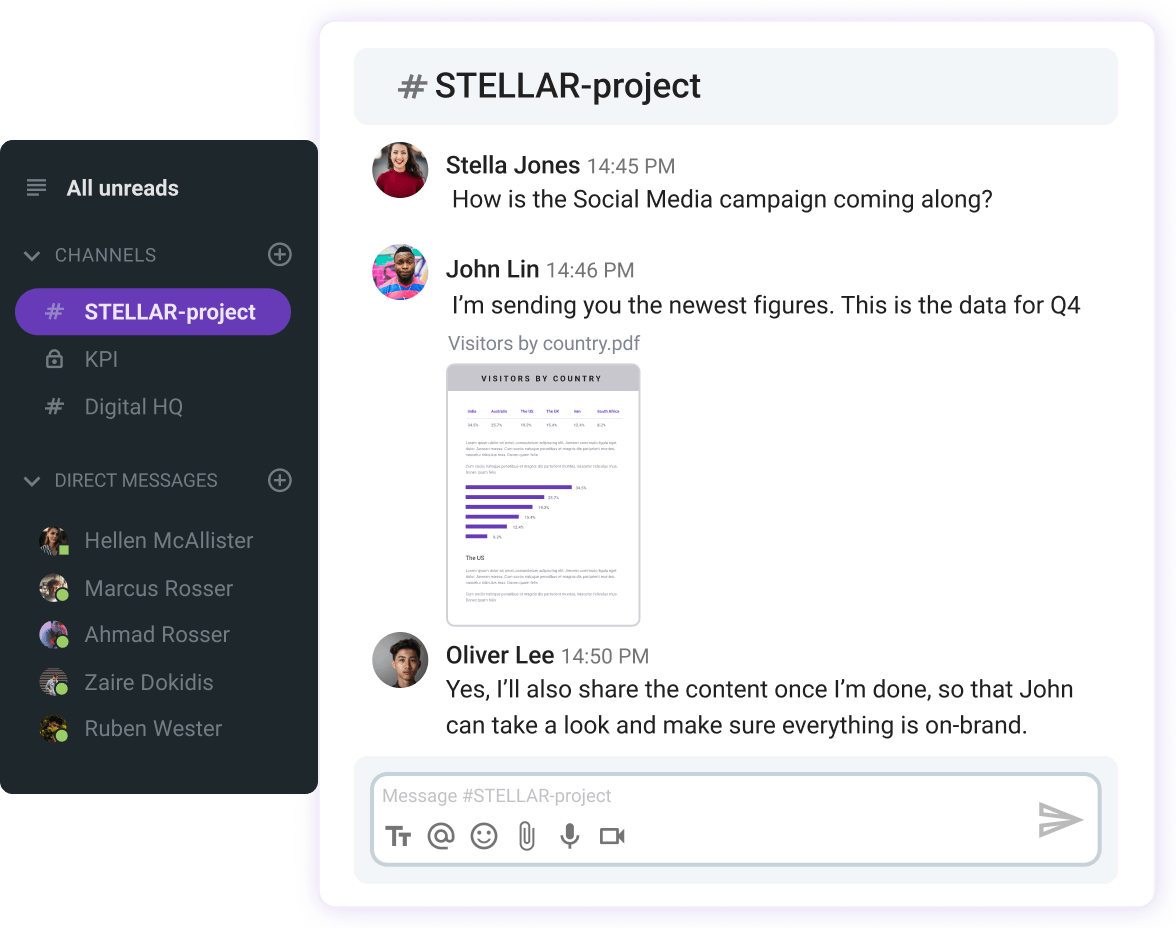
Consejo 9: No subestimes el poder del team building
Aunque algunas personas ignoran el poder del team-building, estas actividades son una herramienta clave para mejorar la colaboración y la cohesión en el trabajo en equipo entre los miembros del equipo.
Según un artículo de Forbes, el team building eficaz es la inversión más importante de toda organización exitosa, porque conduce a:
- Empleados más comprometidos,
- Mejor colaboración, y
- Buenas vibras entre los empleados.
En lo que respecta a los ejercicios de team-building, Gordon enfatiza la importancia de cumplir con los siguientes criterios:
- Vulnerabilidad,
- Transparencia, y
- Autenticidad.
Los ejercicios de team building que llevan a las personas a ser vulnerables, transparentes y auténticas son formas efectivas de acabar con su ego y mejoran la conexión entre los miembros del equipo. Como resultado, tienen relaciones significativas y se comprometen más con el equipo.
Los componentes de las actividades de team-building, como la narración de historias vulnerables, las experiencias compartidas y los desafíos comunes, son formas poderosas de establecer un entorno de trabajo positivo y mejorar la colaboración y el desempeño del equipo.
¿Cómo generar confianza en el equipo?
“La confianza es la base de todos los equipos y, sin ella, no pueden desempeñarse bien.”
― Eric Coryell
En su libro sobre trabajo en equipo Revolutionize teamwork: How to Create and Lead Accountable Teams, Eric Coryell describe principios efectivos para un grupo productivo, que incluyen conductas de equipo que aumentan la confianza y conducen a un mejor desempeño y colaboración en equipo.
En lugar de ignorar los problemas o hablar mal de los compañeros, Coryell confía en la importancia de abordar los problemas reales juntos.
Trabajar juntos para resolver los problemas es beneficioso para la colaboración en el trabajo en equipo de las siguientes maneras:
- Aporta diferentes perspectivas y genera más opciones de solución ― cuando todos los miembros del equipo comparten sus pensamientos y diferentes perspectivas, es más probable que el problema se resuelva con éxito y eficiencia. Además, todos pueden contribuir a la resolución de problemas, lo que aumenta el sentido de compromiso.
- Aumenta la transparencia en el equipo y el apoyo entre los miembros del equipo ― la comunicación transparente reduce las posibilidades de mala comunicación y de hablar a espaldas de alguien.
- Contribuye a establecer expectativas y límites claros ― cuando los miembros del equipo abordan el problema y lo resuelven juntos, es fácil establecer normas y límites grupales.
- Fortalece al equipo y aumenta la confianza ― las relaciones del equipo se enriquecen con más confianza y compromiso.
Asegúrate de que la comunicación con Pumble sea transparente
Los errores más comunes que rompen la confianza
Coryell enfatiza la importancia de la confianza en el trabajo en equipo y describe los errores más comunes que dañan la confianza:
- Hablar mal de los demás antes de abordar un problema real, y
- La tendencia de los miembros del equipo a no hablar en su propio nombre.
La mayoría de las personas tienden a hablar sobre el problema a espaldas de la otra persona para obtener información adicional o validar su punto de vista.
Sin embargo, esta práctica es ciertamente una forma ineficaz de resolver el problema. Aunque algunas personas se sienten mejor y se revelan cuando lo hacen, este comportamiento lleva a consecuencias negativas a largo plazo que pueden dañar significativamente el trabajo en equipo y la confianza.
Además de hablar a espaldas de los demás, evitar hablar por sí mismos es la forma más perjudicial de resolver problemas reales.
La gente suele hacerlo utilizando pronombres grupales, como nosotros o ellos. En lugar de decir: “He notado que llegas tarde a las reuniones últimamente”, algunas personas dicen: “Hemos notado que llegas tarde a las reuniones últimamente.”
Los principales problemas con este tipo de comunicación son los siguientes:
- El miembro del equipo puede confundirse fácilmente debido a su ignorancia de lo que quieres decir con "nosotros",
- Puede llegar a la conclusión de que ya has estado hablando con otra persona sobre él sin su conocimiento, por lo que aquí la confianza comienza a destruirse.
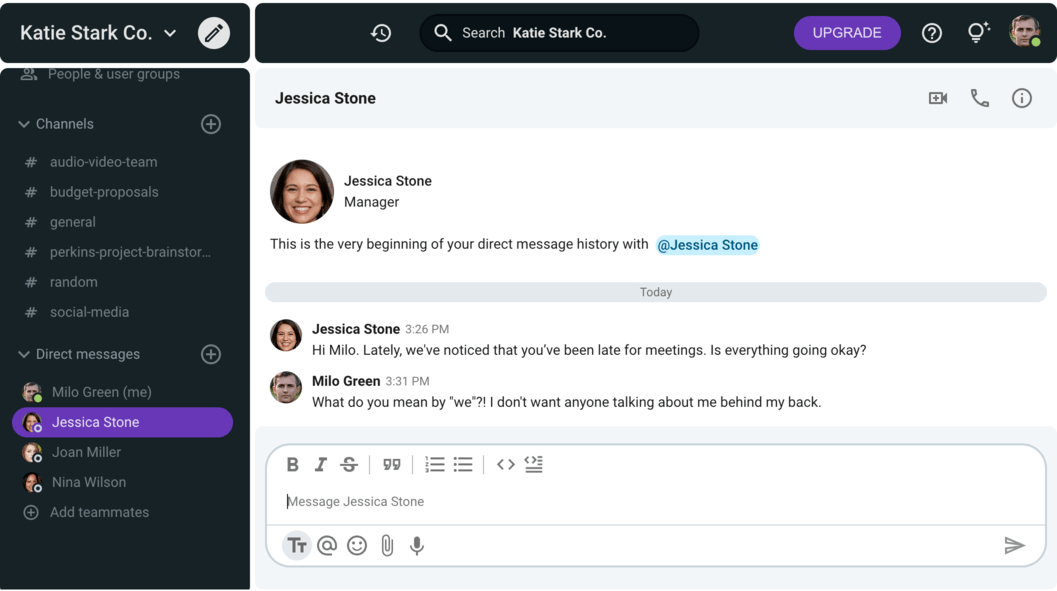
El segundo comportamiento que demuestra que se evita hablar por uno mismo es hacer una pregunta en lugar de hacer una afirmación.
La mayoría de las personas suelen hacer preguntas sugerentes cuando quieren que otras personas estén de acuerdo con ellas, lo que sin duda es una práctica de comunicación ineficaz.
Por ejemplo, preguntan: “¿No crees que deberíamos cambiar nuestras prioridades de tareas?" En cambio, una forma más adecuada de comunicarse es decir algo como esto: “ Creo que sería una buena idea si priorizáramos nuestras tareas de forma ligeramente diferente.”
De esta manera, te comunicas de forma asertiva y demuestras tu respeto, sin agresividad pasiva.
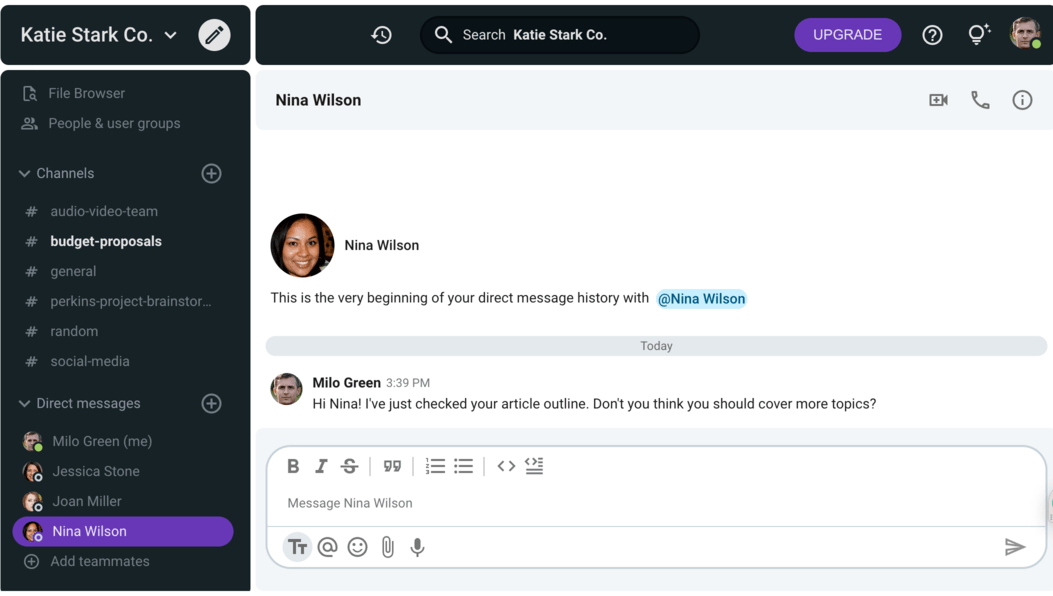
Fomenta la comunicación asertiva en Pumble
🎓 Consejo Pro de Pumble
Para obtener más información sobre los comportamientos que conducen a una mala comunicación en el equipo, consulta el siguiente artículo:
¿Cómo generar la responsabilidad y gestionarla de manera inteligente?
Uno de los desafíos más comunes que enfrentan los equipos es un enfoque inadecuado para la gestión de la responsabilidad. En otras palabras, puede suceder que no esté claro si el líder o los miembros del equipo deben encargarse de un determinado problema.
Debido a las expectativas poco claras, el equipo puede quedarse estancado en problemas no solucionados, por lo que es fundamental dejar en claro qué decisiones son responsabilidad del líder y cuáles son responsabilidad de los miembros del equipo.
Además de las seis etapas de creación de consenso de Straus que ya hemos analizado, existen varios modelos de toma de decisiones, pero uno de los más comunes que implementan los equipos exitosos es el modelo RACI.
Consejo 1: Implementa el modelo RACI
El modelo RACI (también conocido como el matriz RACI o matriz de asignación de responsabilidades) se puede implementar en varios procesos:
- Procesos de toma de decisiones,
- Procesos de resolución de problemas, y
- Procesos de gestión de proyectos.
Según el modelo RACI, independientemente del tipo de proceso, los equipos deben aclarar quién es:
- Responsable (Responsible, en inglés) ― Una o varias personas que son responsables de completar la tarea; dicho de otro modo, quién es el dueño de la decisión o el problema. Por lo general, desempeñan funciones de desarrollo.
- Responsable (Accountable, en inglés) ― Las personas responsables suelen ser gerentes o líderes, por lo que lideran a las partes encargadas para asegurarse de que comprenden las expectativas.
- Consultado (Consulted, en inglés) ― Partes a las que se consulta antes de tomar una decisión, abordar un problema o completar la tarea; brindan aportes y feedback.
- Informado (Informed, en inglés) ― Personas que deben estar informadas sobre la resolución del problema, la decisión o el progreso del proyecto. Por lo general, trabajan como jefes, directores o líderes sénior.
Consejo 2: Comunica las expectativas con claridad
Todos los miembros del equipo deben saber qué se espera de ellos de manera individual y colaborativa. Además, todos deben recibir feedback sobre su desempeño de manera transparente y clara.
Tener conversaciones sobre el desempeño con tus compañeros de equipo o con el líder del equipo de manera oportuna y asertiva contribuye en gran medida a la colaboración en equipo y a un buen ambiente en el equipo.
En lugar de hablar a espaldas de los demás, una de las mejores prácticas de trabajo en equipo es comunicar las expectativas, ya que ayuda a:
- Generar confianza,
- Mejorar el desempeño, y
- Incrementar el compromiso.
🎓 Consejo Pro de Pumble
Si no estás seguro de cómo y cuándo pedirle feedback a tu gerente, consulta nuestra publicación de blog sobre el tema:
Consejo 3: Predica con ejemplo
Según Coryell, dos factores principales que definen el liderazgo son:
- El comportamiento del líder, y
- Lo que tolera.
Por lo tanto, como líder de equipo, solo puedes cambiar y mejorar tu equipo si modificas tu comportamiento y dejas de tolerar las conductas de los demás que dañan la confianza y la colaboración en el equipo.
Por ejemplo, si no quieres que tus compañeros de equipo hablen sobre un tema sin que los demás lo sepan, asegúrate de que tú mismo no lo hagas nunca.
Si eres consciente de la importancia de hacer declaraciones en lugar de hacer preguntas pasivo-agresivas, deja de tolerar este comportamiento en ti mismo y en los demás compañeros de equipo.
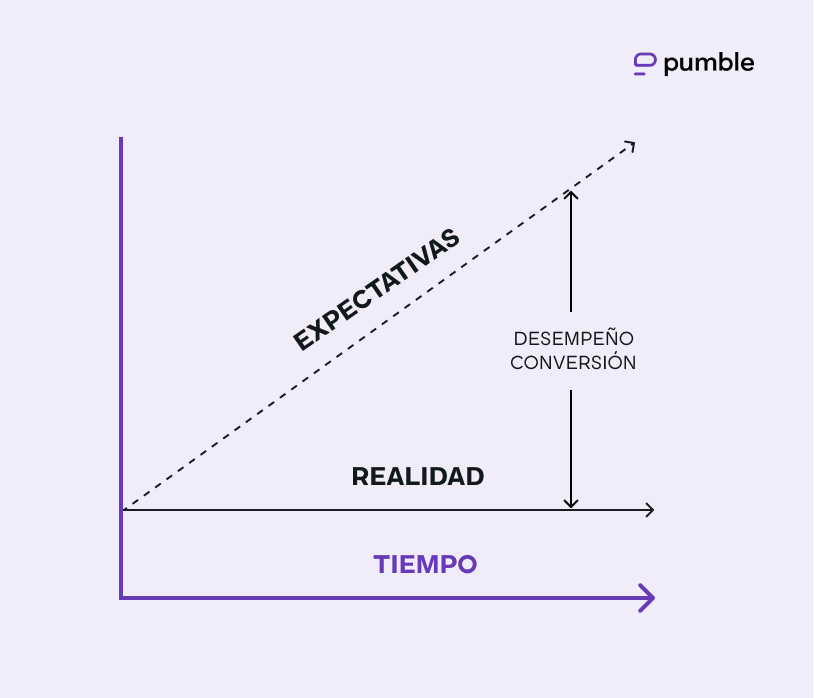
🎓 Consejo Pro de Pumble
Si quieres obtener más información sobre la comunicación de liderazgo eficaz, consulta las publicaciones de nuestro blog:
Estrategias de RR.HH. que enseñan a los empleados a colaborar y fomentan un sentido de comunidad
Según un artículo de Harvard Business Review, los estudios han demostrado que dos prácticas de RR.HH. tienen un gran impacto en el desempeño y la colaboración del equipo:
- Capacitar a los empleados para garantizar un comportamiento colaborativo, y
- Apoyar el sentido de comunidad.
La primera estrategia de RR.HH. puede marcar una diferencia importante en la colaboración del equipo al mejorar las habilidades de los empleados en varias áreas, como la resolución de conflictos.
Cuando se trata de apoyar el sentido de comunidad como estrategia de RR.HH., incluye eventos y actividades que hacen que los empleados se sientan parte de la comunidad, lo que fomenta un entorno de trabajo positivo.
La comunidad en el lugar de trabajo contribuye a la conexión significativa entre los empleados, lo que conduce a un mayor compromiso y una mejor conexión con el trabajo.
Para garantizar una colaboración productiva en equipo, los líderes del equipo deben estar orientados tanto a las tareas como a las relaciones; por lo tanto, implementar estrategias de RR.HH. adecuadas es sin duda una gran ayuda para lograrlo.
🎓 Consejo Pro de Pumble
Las citas sobre el trabajo en equipo nos ayudan a comprender la importancia de una colaboración y comunicación eficaz en equipo. Para encontrar citas inspiradoras para una mejor colaboración, consulta el siguiente artículo:
Utiliza Pumble para impulsar la colaboración productiva
La colaboración productiva es un proceso delicado que depende de una variedad de factores. Como mencionamos antes, la comunicación eficaz es uno de los más importantes y se puede facilitar fácilmente utilizando las herramientas adecuadas.
Pumble es la aplicación de comunicación en equipo ideal para todos los equipos que quieren mejorar la productividad y garantizar el éxito de toda la empresa. Pumble puede adaptarse a todas las diversas necesidades y preferencias para crear un entorno de colaboración perfecto. Con su interfaz intuitiva y sus funciones integrales, Pumble fomenta el diálogo abierto, la toma de decisiones rápida y la gestión eficaz de tareas y proyectos.
Si bien la colaboración productiva requiere una atención cuidadosa a varios elementos, la comunicación eficaz es su piedra angular. Al aprovechar herramientas como Pumble y fomentar una cultura de colaboración, los equipos pueden superar los desafíos, aprovechar las oportunidades y, en última instancia, impulsar el crecimiento y el éxito organizacional.
Permite que tu equipo alcance la grandeza más allá de las capacidades individuales: Crea una cuenta en Pumble gratuita hoy mismo.
Cómo revisamos esta publicación: Nuestros escritores y editores monitorean las publicaciones y las actualizan cuando hay nueva información disponible, para mantenerlas frescas y relevantes.

